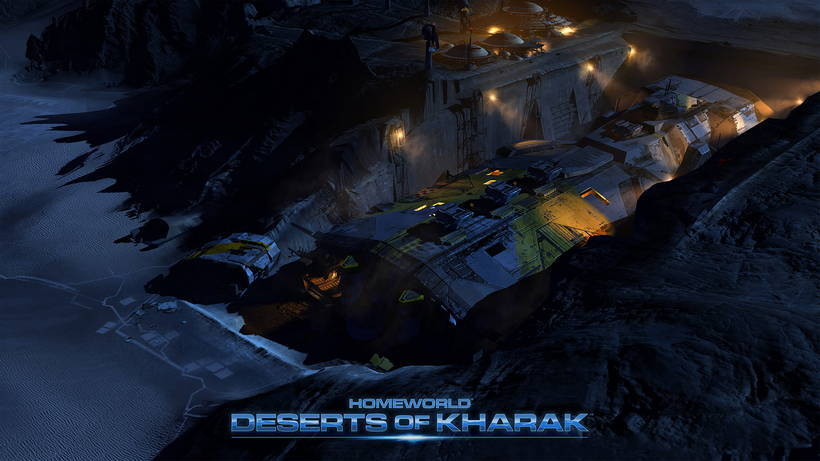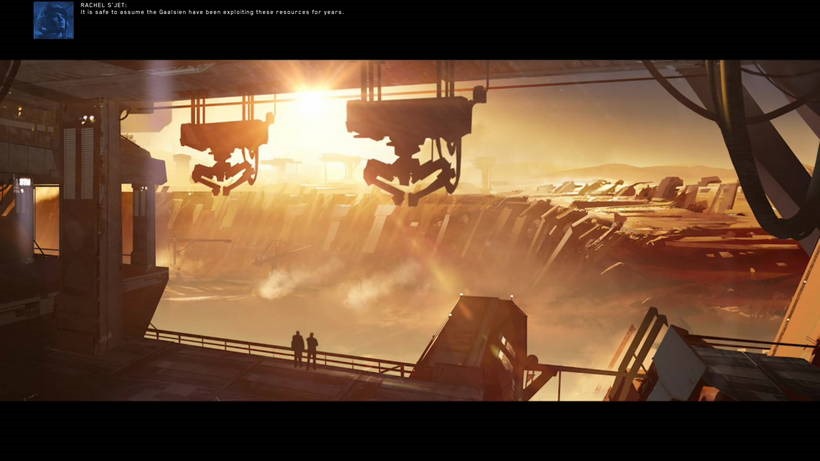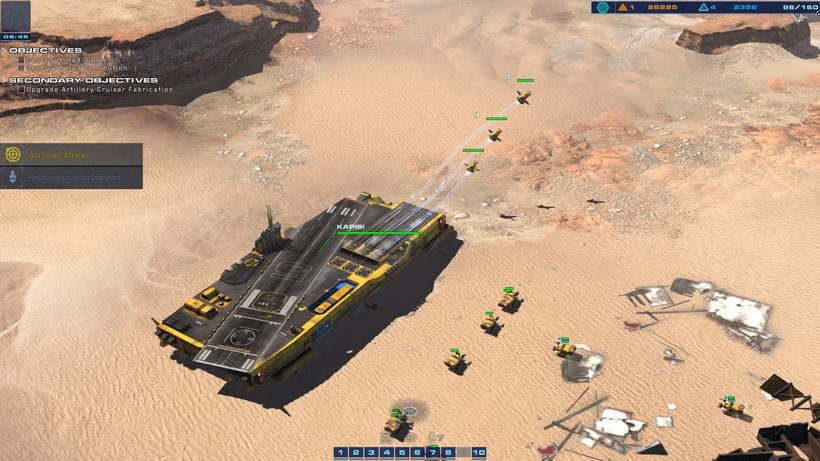A prequel to the first Homeworld game, Homeworld: Deserts of Kharak bears its heritage brightly and proudly, both in its mechanics and narrative. The majority of the team who worked on the first Homeworld game are present in Black Bird Interactive, the studio which made Deserts of Kharak, and it shows clearly. The theme and feel is strongly reminiscent, and nearly nostalgic for how strongly it pulls you back into the Homeworld franchise. The narrative comparison is so strong, in fact, that I was rather concerned that it would be a step by step recreation of Homeworld’s plot and missions instead played out in a desert, and that I’d be able to predict exactly what missions I’d be encountering and in what order.

Much to my relief, by the fourth mission the narrative was walking its own path, albeit still one regarding a desperate quest, and discovery. The story delves into the Hiigaran history on Kharak after that first deep desert discovery, first detailed in the introduction cinematic of the first Homeworld game, and the revelation as they realized what it truly was, and what it revealed about the history of the Hiigaran people.
Long before it was destroyed, the planet Kharak was dying a slow death. The deserts grew as the water shrank, pushing many of the clans to clash with each other for dwindling resources. After a satellite discovers a massive anomaly deep within one of the deserts, the Northern Coalition hopes that this discovery, along with hundreds of smaller anomalies detected throughout the desert, may lead to the planet’s salvation. However, that land is controlled by the Gaalsien, a strongly religious and territorial clan, set on keeping the secrets of the desert out of the hands of others. Despite this, and driven by the dim future of their people, an expedition lead by the carrier Kapisi is sent into enemy territory to unravel the mysteries buried within.

The cinematics strongly follow the styling of the older Homeworld games
Importantly, the game retains that sense of exploratory mysticism that was so profound in the Homeworld franchise. While the planet itself is a known entity to the protagonist, they’re exploring a massive chunk of it left abandoned for decades, kept guard and obscured by the Gaalsien. Many of the discoveries the make on their expedition raise new questions and details for fans of the franchise, regarding the Hiigaran exile on Kharak. It is, in the end, a very “Homeworld” narrative, albeit one that definitely feels like it has a lot more meat to it compared to the relatively loose story telling found in the other games.
The storytelling and voice acting is fantastic, retaining the franchises habit of using “cool under pressure” characters allowing that sense of urgency, the sense that this these people under your command are determined, but professional. It’s an interesting contrast to most other game narratives that prefer a more dramatic and emotional approach.
The game’s cutscenes keep to styling of the franchise, though there’s a larger range of motion present, especially when it comes to characters, and conversation. It’s fascinating to watch, and while it using such a medium does make certain character animation a bit awkward at times, it’s also very impressive seeing how they manage to animate certain scenes. The music is fantastic, being immediately familiar, composed by the same fantastic gentlemen who wrote the soundtrack to the original games. The radio chatter is back as well, including chatter between units and controllers outside of combat for things like reading confirmations, radiation spiking, and messages of good luck.

Mission briefings and loading screens are familiar another component from the Homeworld game
Visually, the game is also impressive, many units having glowing bays or windows to allow them to stand out. The desert terrain is surprisingly diverse, from rocky landscapes, to sand dunes with chemical run off staining the areas inbetween them, to giant jutting plateaus. I’ve certainly been impressed with how varied they’ve made an environment which I’d otherwise assume would look rather similar, mission after mission.

One of the impressive wrecks one comes across in the campaign
Mechanically, the similarities to Homeworld are even stronger. Once again you have a single massive production ship, a gigantic land carrier named the Kapisi, which produces the majority of units you’ll be using. The tech tree is advanced entirely with research, rather than any need to build specific buildings or units, and this is again all achieved at the Kapisi. Hitting space brings up a familiar blue tactical map, along with that same “bwooo” sound affect when it opens, allowing one to survey the map along with brightly indicated resources, the height of terrain, and enemy and friendly units, along with markers for objectives and other campaign related objects.
Unlike previous Homeworld games, that central “mothership” unit serves a very capable offensive role when upgraded. Outside of its normal defensive upgrades, which can be quite potent themselves, it serves as a launching platform for strike craft and bombers that fly across the map to engage ground targets, as well as other powerful long range strike weaponry. The distance and speed at which these offensive capabilities can strike largely make up for the Kapisi’s painfully slow movement, allowing it to support your units anywhere on the map with devastating artillery and air support.

The Kapisi, launching a squadron of interceptors
The Kapisi, and Carriers in general when it comes to multiplayer, also has a power management system that allows you to shunt power to different systems to increase their, being Armour, Repair, Attack Power, and Attack Range. Each increase in effectiveness eats more power and generates more heat, and pouring enough energy into systems will cause overheating risks, and should only be done as a temporary measure.
In terms of general unit combat, there’s a slightly larger focus on Rock-Paper-Scissors, at least initially. Light attack vehicles get chewed up by more heavier “generalist” units, which get chewed up by “anti-armour” units, which in turn get chewed up by the light attack vehicles as their anti-armour fire have a hard time hitting the smaller and faster craft. This three way balance does seem to get muddied up as one advances up the tech tree, where the fragility of the light attack vehicles can make it difficult to use them effectively in larger brawls, and longer range bombardment starts making combat a very chaotic affair.
Formations are gone unfortunately, so moving a group of mixed units can be problematic at times, as the units all move at their own pace, so one has to be careful of the faster units arriving early, only to be chewed up while they wait for their backup to arrive. Thankfully, units don’t need to fight each other to move as they clip through each other as needed. Though it often looks awkward, it’s much preferred than having to fight with pathing.
The rise and fall of the sand dune terrain isn’t only visually pretty, but also adds an interesting aspect to combat. They block line of sight, though sensors may pick up that there are units there – you just won’t know what the enemy force comprises of, but more importantly having the higher ground grants accuracy bonuses. It’s always really damned cool to watch your army climb the apex of a dune, and then descend down and into onto an enemy force below, though it can be difficult to remember to use this to your advantage in the heat of combat.

An armed force wiping out a Gaalsien patrol
Taking a note from Homeworld: Cataclysm, units that survive long enough gain increasing veterency, providing both defensive and offensive buffs, as well as motivation to keep units alive. Veterency is racked up relatively quickly, so it’s never that much of a disaster if your battle hardened unit dies when you weren’t looking, though you will pout heavily.
Veterency tends to have a larger effect on the campaign as, similar to other Homeworld games, the force you build is persistent as you progress from mission to mission. This does potentially result in you simply bulldozing your way through enemy forces with your accumulated army, but the design team has made some very interesting design decisions to keep the game challenging, even if you’ve a massive and veteran force.
Resourcing has undergone some departures from the Homeworld formula as well – most notably the inclusion of a secondary more limited “tech” resource, such as Vespene Gas from Star Craft, or Power from Dawn of War. Most resources also need to be gained by “Shipbreaking”, which is blowing up segments of ancient ship debris scattered around the map. These can also reveal Relics, which once recovered provide permanent bonuses, such as reducing the population cost of certain units, increasing armour, or granting the Kapisi more energy. In the campaign, this allows a gradual increase of power as you progress through the story, while in multiplayer fighting over relics is one of the main ways to compete for victory.
The campaign flows nicely, and I’ve had an absolutely fantastic time playing it. It’s been wonderful to return to good RTS storytelling, along with an engaging and challenging campaign that reeled me in and kept me playing. I did note that several missions did fall into the “sit back and prepare before you trigger that next story event” nature that’s present in many Homeworld games, but I’ve always enjoyed that small bit of respite, even if I’m taking advantage of how missions play out – I always did love that Homeworld 1 allowed you to end the mission whenever you wanted, and still wish to see more of that. There are also tons of smaller details that Homeworld fans will pick up on, especially if one recalls all the story details from the amazing manual that came with the first game – and the stories’ mysteries are wonderful to unearth.
Last Updated: February 9, 2016
| Homeworld: Deserts of Kharak | |
|
Homeworld: Deserts of Kharak is a fantastic Homeworld game, and a fantastic RTS game in its own right. It’s a great middle point between the classic formula and the rather intimidating full three dimension movement of the franchise, as well as just being a damned good RTS in a time when games in the genre are an increasingly rare sight.
|
|
|---|---|
| Homeworld: Deserts of Kharak was reviewed on PC | |
|
79 /
100
| |





















Jim Lenoir (Banana Jim)
February 9, 2016 at 13:36
Yep, that’s going onto my birthday wishlist.
Alien Emperor Trevor
February 9, 2016 at 13:44
That’s 12 August right, Skynet?
RinceThis
February 9, 2016 at 13:59
Ohhhh.
Captain JJ 'saurus
February 9, 2016 at 14:25
LOL
RinceThis
February 9, 2016 at 14:00
I was going to invite you to the next meet up, but @tre@disqus_DoEH3TsffU:disqus and I know you will be in the background anyway…
Commander Admiral Chief
February 9, 2016 at 14:08
He is lurking on some dodgy server
RinceThis
February 9, 2016 at 14:09
You KNOW it.
Commander Admiral Chief
February 9, 2016 at 14:08
Lies, banana’s cannot PC
Jim Lenoir (Banana Jim)
February 10, 2016 at 10:45
PC Cannot BANANA!!!
Commander Admiral Chief
February 9, 2016 at 14:08
Nice one Daniel!
Captain JJ 'saurus
February 9, 2016 at 14:26
I’m still loving my Homeworld 1 and 2. Now with the remakes having brought new life to them it’s going to take me even longer before I will get this one…but I will probably get it.
That said. I miss the good old RTS games with proper base building. The only recent game able to manage that properly is Grey Goo (Planetary Annihilation is just embarrassing).
HvR
February 9, 2016 at 15:09
Mmm, loved 1 but never finished it and never got to 2. Should maybe have a look at the remakes.
also miss those, had fun with SC2 campaign but it is not PROPER base building.
Captain JJ 'saurus
February 9, 2016 at 15:11
Agreed. Grey Goo has decent walls, and all of that (depending on the faction). They’ve also apparently added another faction, but I’ve not tried it yet. I still play Total Annihilation a lot though.
They changed the entire interface with the new Homeworld remakes. You can even play with HW1 factions against HW2 factions….but the HW1 factions are way superior
Lardus-For the Chimichangas!
February 9, 2016 at 14:42
Since I can’t even run XCom 2 properly, this game will need to wait 🙁
Geoffrey Tim
February 9, 2016 at 14:55
This game is much better tuned than XCOM 2 is /at the moment/
Commander Admiral Chief
February 9, 2016 at 14:57
I think he was referring to the fact that his rig is underpowered (for now)
Lardus-For the Chimichangas!
February 9, 2016 at 15:02
Exactly this! Built it in 2007 and, well, there are no more upgrade parts available for it other than buying a new one 🙁
HvR
February 9, 2016 at 15:05
My 2009 rig sommer decided to retire itself.
Luckily the work laptop can potentially run a couple of modernish RTS games.
Matthew Hughes
February 9, 2016 at 14:58
Can you compare this to Supreme Commander? in terms of scale and amount of units.
Captain JJ 'saurus
February 9, 2016 at 15:12
After Total Annihilation and Supreme Commander, I haven’t seen anything that can compare with those two again.